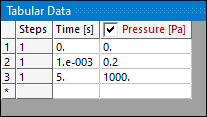Loads applied to static structural, transient structural, rigid dynamics, steady-state thermal, transient thermal, magnetostatic, electric, and thermal-electric analyses default to one of the following:
Step-applied or stepped: The values applied at the first substep stay constant for the rest of the analysis.
Ramped: The values increase gradually at each substep.
The difference between stepped and ramped loading is shown in the following illustration.
You can edit the table of load vs. time and modify this behavior as needed.
By default, an analysis has one step. However you may introduce multiple steps at time points where you want to change the analysis settings (such as the time step size) or when you want to activate or deactivate a load. For example, you can delete a specified displacement at a point along the time history.
You do not need multiple steps simply to define a variation of load with respect to time. You can use tables or functions to define such variation within a single step. You need steps only if you want to guide the analysis settings or boundary conditions at specific time points.
When you add loads or supports in a static or transient analysis, the Tabular Data and Graph windows appear. You can enter the load history, that is, Time vs Load tabular data in the tabular data grid. Another option is to apply loads as functions of time. In this case you will enter the equation of how the load varies with respect to time. The procedures for applying tabular or function loads are outlined under the Specifying Boundary Condition Magnitude section.
Note:
You can also import load histories from or export load histories to any pre-existing libraries.
If you have multiple steps in your analysis, the end times of each of these steps will always appear in the load history table. However you need not necessarily enter data for these time points. These time points are always displayed so that you can activate or deactivate the load over each of the steps. Similarly the value at time = 0 is also always displayed.
If you did not enter data at a time point then the value will be either a.) a linearly interpolated value if the load is a tabular load or b.) an exact value determined from the function that defines the load. An "=" sign is appended to such interpolated data so you can differentiate between the data that you entered and the data calculated by the program as shown in the example below. The following example shows data entered at Time = 0 and Time = 5. The value at Time = 1e-3, the end time of step 1, is interpolated.



